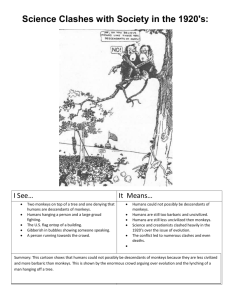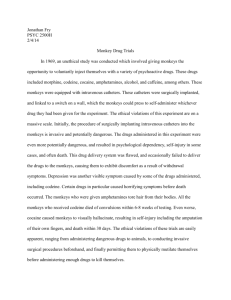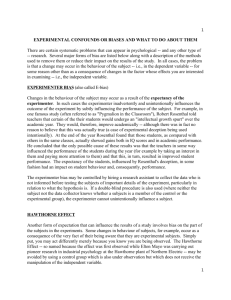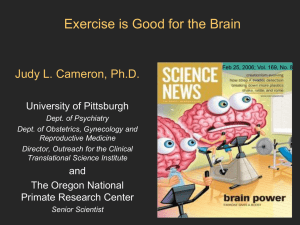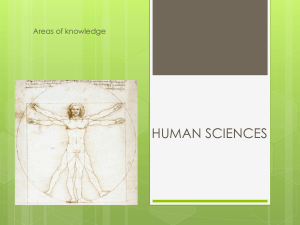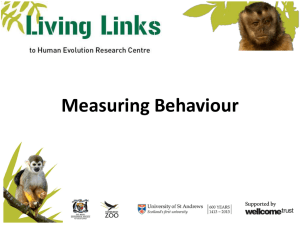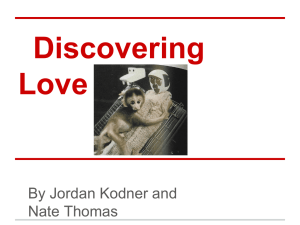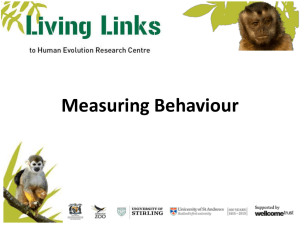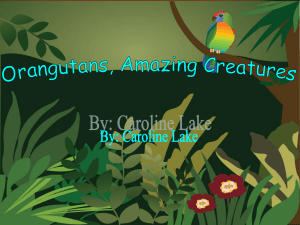Working with Scientific Literature PPT
advertisement
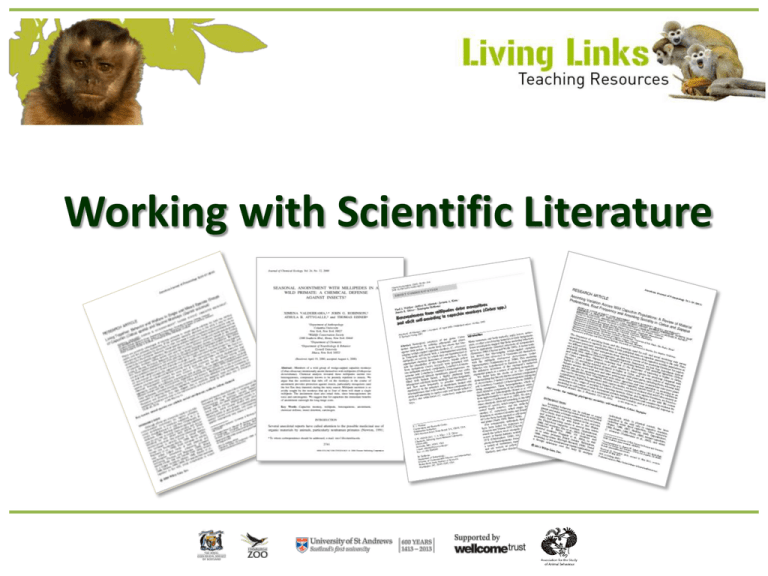
Working with Scientific Literature Overview • • • • • What is scientific literature How to find it How to read it How to use it Source reliability Scientific Literature? • • • • • • Scientific Journals (Primary source) Books (Secondary source) Online Journals and books Science Magazines Newspapers Websites Scientific research is based on questions As a scientist you will read scientific literature and question the ideas, hypotheses and experiments of other scientists to gain more knowledge. If….then…statements Task 1 • What is your current knowledge of monkeys? • What else would you like to know about monkeys? Task 2 Observe some interesting capuchin monkey behaviour at Edinburgh Zoo. http://vimeo.com/48287363 Did any of you have previous knowledge of this behaviour ? (i.e. Did you write this down in Task 1?) Workbook Questions 1.Describe the behaviour of the monkeys in the clip. 2.Why do you think the monkeys are behaving in this way? Do all monkeys do this? 3. Before today did you know monkeys behaved in this way? 4.This behaviour is happening because.........Initial idea? 5.How could you prove your idea? This is the hard bit! Experiments? 6.How would you find out if other scientists had the same or different ideas to you? 7.Where would you go to find this information? 8.How would you start to search? Key words? 9.What key words would be relevant to describe what you just saw? Task 3 – Key Words Find out more! What key words would you use to describe the monkeys’ behaviour? monkey behaviour rubbing plant Key Word Search Millions of hits! Skim through the first few hits. Decide if they may be of use to you. New Key Words Understand Your Key Words Social – Friendly companionship or relations. Could also pertain to group/community living. Self - Anointing – To smear with any liquid Find & Save the Literature • This can take some time and patience. Don’t give up…dig deep! • Free or paid articles • Free abstracts • Save papers and abstracts • Note URLs and date accessed! Find 3 papers about your topic. Task 4 – Find 3 papers 1. Identify the type of source (journal, book, etc). 2. Take note of the name of the source and authors and date published (URL address and date accessed if online). 3. Read the abstract. The abstract will have a brief summary of the paper and thus is very useful as it gives you information quickly. 4. Take note of key words if found How to read it - The Basics Name of the journal, volume and year published Title of the paper Author(s) of the paper Corresponding author* Author(s) Institutes Sections of a Scientific Paper This is not like reading a book Abstract – Summary Introduction – Background and why you did the study. Methods – Very specifically how you conducted the study. Results – Just the facts and figures on what you found out. Discussion – Explain your results, what does it mean? What have you proved or disproved? Read the Abstract Abstracts state the ; Why – purpose How – method Results – findings Conclusions – what it all means Highlight the why, how, results and conclusions in the Valderrama et al, 2000 abstract. Read the Introduction Look out for sentences like; • We hypothesise that/the objective/aim was … • We report/suggest/propose … • In contrast to/agreement with previous work by… Highlight both the first and last few sentences of each paragraph. Skim the Methods Study Subjects An explanation of the experiments that were done. These can be difficult to read and are often quite technical. But it all comes down to what was measured. If the method is of interest to your study read them carefully so you can use their methods in your experiments. Study Site Fundo Pecuario Masaguaral, cattle ranch and private reserve in the Llanos of central Venezuela Understand the Results Look at pictures, figures and tables. What has been measured? Are there identifiable trends? Read the Discussion • The discussion can be the most important part of the paper. • It puts everything into context, connecting the background information, your results and explains to the readers why this research added to the field of study. • This section allows you to have creative ideas on the interpretation of your results as well explain why you did or didn’t get the results you expected. References The reference section helps with your literature search. Use it to find more articles. (Note the Valderrama paper is included in the Lynch review) Referencing papers and websites in your own research project is a NECESSARY skill to learn. There are various ways to reference, the Harvard system is a widely accepted one http://libweb.anglia.ac.uk/referencing/harvard.htm How To Reference In Text Citing a research paper with 2 authors Previous studies have shown benzoquinones to be potent insect repellents (Peschke and Eisner, 1987). (Author 1 and Author 2 comma Year of publication) . Reference list Peschke, K., and Eisner, T. 1987. Defensive secretion of the tenebrionid beetle, Blaps mucronata: Physical and chemical determinants of effectiveness. Journal of Comparative Physiology. 161, 377– 388. Author, Initials., Year. Title of article. Full Title of Journal, Volume number (Issue/Part number), Page number(s). How to use Sci Lit Background Information Find out what research has already been done on your topic of interest. Methodology Replicate someone else’s study by using their methods. Discussions Come up with your own results then use the research papers to back up your thoughts. E.g. In our study on capuchin anointing behaviour we found…which was a similar result to a previous study done by Valderrama et al in 2000. Peer Review – Reliabilty? The process by which papers and books are evaluated by other scientists working in the same area. It aims to improve the quality of publications by highlighting errors, bias and weakness in the material. These issues must be resolved by the scientist prior to acceptance for publication. As a result the publication is more reliable. Research or Review??? You may come across two main types of papers: Research papers publish original experiments and data carried out by a particular group of scientists. Reviews – summarise already published research findings from many groups of scientists. Reviews give an overview of all research in a particular field which can be very useful. Review Is this accurate/reliable science communication? SCREEN SHOT ONLY http://vimeo.com/48287364 Popular media – Do news papers accurately reflect real science? This article was written by a science journalist for the New York Times http://www.nytimes.com/2000/12/05/science/for-monkeysa-millipede-a-day-keeps-mosquitoes-away.html It relates to the Valderamma et al. 2000 paper you have read. Do you think it is scientifically accurate? Well written? Reliable? Web articles – Reliability? This article is relevant to the paper written by Weldon et al. 2003 http://mentalfloss.com/article/52378/monk eys-use-mosquito-repellent-too This article is relevant to the Valderamma et al. 2000 paper http://cei.org/news-letters-ceiplanet/monkeys-and-millipedes Misrepresentation? In an attempt to gain readers, headlines can often misrepresent the real story. The following headlines come from three websites ‘Animals get stoned on bugs’ ‘Animals that love to get high’ ‘Monkeys get high in Florida’ Same video different headline Medicinal millipedes http://www.animalplanet.com/tvshows/other/videos/fooled-by-naturemedicinal-millipedes.htm Animals on Drugs https://www.youtube.com/watch?v=LwQ0ZiTYkQ Acknowledgements Resource designed by Alaina Macri- RZSS – Edinburgh Zoo and Deirdre McCarthy - ASAB (Association for the Study of Animal Behaviour) • Wellcome Trust • Dr Mark Bowler and Dr Emily Messer – University of St Andrews
